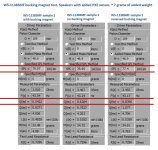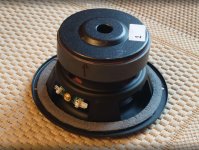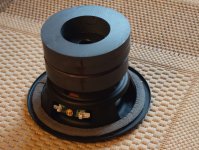You are describing "bucking" magnets [ magnetic fields opposed] there whilst the discussion is about "piggyback" magnets [ magnetic fields aligned]
There is a difference
There is a difference
That is correct. Putting the added magnet in 'series aiding' with the speaker's one would worsen the situation.
re:'Ferrite magnets can and Do lose flux" I think you'll find that Ferrite magnets are relatively stable, wheras Alnicos are more prone to losing magnetic strength
I sketched the fields of an additional magnet on the back of an envelope, both the same orientation and the opposing orientation. There are obviously big differences in the external field depending on orientation (which is why bucking magnets are attached opposing the main magnet) but frankly at the voice-coil gap it isn't clear how the polarity of the extra magnet would make much difference.That is correct. Putting the added magnet in 'series aiding' with the speaker's one would worsen the situation.
I took an old Vifa M21WG-09-08 woofer with a QES of 0.79, and with 1 Neo ring magnet on the back I measured a QES of 0.64, and with two I measured 0.58. There's also an extra 1db sensitivity with the two magnets.
I really should revisit this experiment with distortion and frequency response comparisons...
I really should revisit this experiment with distortion and frequency response comparisons...
I have measured 2dB higher sensitivity of a woofer with bucking magnets.
I had some drivers with Neodymium magnet rings. I first tried 1 bucking magnet and it gave approx 1 dB extra output playing white noise.
3 magnets extra gave slightly more than 2dB extra output.
It increases the total flux of the magnet system and i guess it helps keeping the ferrites magnetized longer over time as well. Another benefit is the added mass that counteracts the reactive forces from the voice coil, which gives more dynamics and less vibrations. And it requires less power from the amplifier to produce same SPL!! Actually if you think about it, it reduces the amount of necessary electrical current in the voice coil and less power dissipation. And less power compression. Lower power in the voice coil means less temperature buildup.
If you build your own speakers, do not hesitate to experiment with bucking magnets!
I had some drivers with Neodymium magnet rings. I first tried 1 bucking magnet and it gave approx 1 dB extra output playing white noise.
3 magnets extra gave slightly more than 2dB extra output.
It increases the total flux of the magnet system and i guess it helps keeping the ferrites magnetized longer over time as well. Another benefit is the added mass that counteracts the reactive forces from the voice coil, which gives more dynamics and less vibrations. And it requires less power from the amplifier to produce same SPL!! Actually if you think about it, it reduces the amount of necessary electrical current in the voice coil and less power dissipation. And less power compression. Lower power in the voice coil means less temperature buildup.
If you build your own speakers, do not hesitate to experiment with bucking magnets!
No measurements just for having a look
https://www.diyaudio.com/community/threads/new-12-full-range-fane-12-250tc.246746/post-7736735
And Troels did measure it in a project, plus 1.5 db with same size magnet:
https://www.diyaudio.com/community/threads/new-12-full-range-fane-12-250tc.246746/post-7738169
https://www.diyaudio.com/community/threads/new-12-full-range-fane-12-250tc.246746/post-7736735
And Troels did measure it in a project, plus 1.5 db with same size magnet:
https://www.diyaudio.com/community/threads/new-12-full-range-fane-12-250tc.246746/post-7738169
I think it’s a bit difficult to assess if there is a benefit or not if we don’t try measuring both sides of the magnet. I.e. measuring N-N and S-N. N-N orientation may focus the field through the backplate where S-N would diffuse it.
As far as I am aware the addition of a magnet, on the back of a driver outside the magnetic circuit, operates on the principle of redirecting the stray field produced my the main magnet. That is flux is lost from the magnet within the magnetic circuit by the stray field it produces and the additional magnet forces this flux back where its useful.
Contrary to what some have said here this can have a significant affect on the sensitivity and final Qts of said driver but it's going to heavily depend on the construction of the magnetic circuit of the driver in question.
Troels did this here...
http://www.troelsgravesen.dk/C20WH.htm
Contrary to what some have said here this can have a significant affect on the sensitivity and final Qts of said driver but it's going to heavily depend on the construction of the magnetic circuit of the driver in question.
Troels did this here...
http://www.troelsgravesen.dk/C20WH.htm
Looks like Troels placed his magnets N-N or S-S and then due to the repulsive force had to glue them on. This is what I thought would work. Don’t just slap the magnet on the back of your woofer, press the repelling sides together and glue that sucker on with JB Weld. This will increase the magnetic force. Cool!
Measure the Qts of the driver in both orientations. Shielding with opposed fields will cause the Q to go up. Correctly adding the fields will lower Qts. Mark with a sharpie the right orientation, remove to add epoxy, and place back on the driver in the correct placement.
You'll find that the initial fields will repel, but once pushed through them, it will attract just fine.
You'll find that the initial fields will repel, but once pushed through them, it will attract just fine.
Adding a magnet to a driver in an already finely tuned design could alter the performance of the design, possibly impairing it.
If a driver I not to spec and has a higher Q than it's supposed to, how else are you going to improve the specs?
To add a bit of info to the thread.
I have tried adding additional magnet in an effort to decrease a bit the Qts of Tang Band W5-1138SMF speaker.
It works.
I have tried adding additional magnet in an effort to decrease a bit the Qts of Tang Band W5-1138SMF speaker.
It works.
The correct (Qts decrease in my case) orientation behaves exactly like described by @wolf_teethYou'll find that the initial fields will repel, but once pushed through them, it will attract just fine.
Attachments
- Home
- Loudspeakers
- Multi-Way
- Speaker magnet mod / Attaching addition magnet to the driver, question


